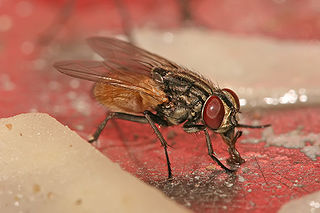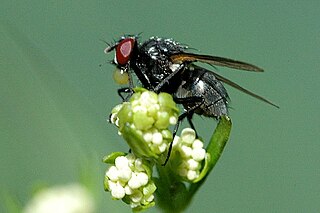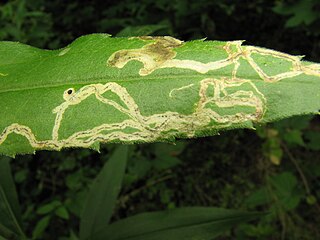
Cordyceps is a genus of ascomycete fungi that includes about 600 species. Most Cordyceps species are endoparasitoids, parasitic mainly on insects and other arthropods ; a few are parasitic on other fungi. The generic name Cordyceps is derived from the Greek word κορδύλη kordýlē, meaning "club", and the Greek word κεφαλή cephali, meaning "head".

Muscidae are a family of flies found in the superfamily Muscoidea.

The crimson fruitcrow is a species of bird in the large family Cotingidae, not a crow. The only member of the genus Haematoderus, it is found in Brazil, French Guiana, Guyana, Suriname, and Venezuela. Its natural habitat is subtropical or tropical moist lowland forests. Because of its large range and population density this species is not classified as vulnerable.

Hydrotaea is a genus of insects in the housefly family, Muscidae. They occur in most regions of the world but are more populous in warmer climates. They are often found on feces in summer months, and are therefore generally found in close proximity to livestock. Among the 130 known species in this genus, one of the most commonly recognized is the dump fly.

Cordyceps militaris is a species of fungus in the family Cordycipitaceae, and the type species of the genus Cordyceps. It was originally described by Carl Linnaeus in 1753 as Clavaria militaris.

Phylini is a tribe of plant bugs in the family Miridae. There are at least 440 described species in Phylini.

Phytomyza is a genus of leaf miner flies in the family Agromyzidae. At least 170 described species are placed in Phytomyza.

Tettigoniidea is an infraorder of the order Orthoptera, with six extant families.

Tabanini is a tribe of horse and deer flies in the family Tabanidae. There are at least 220 described species in Tabanini.

Pisciforma is a suborder of mayflies in the order Ephemeroptera. There are at least 410 described species in Pisciforma.

Phanogomphus is a genus of clubtails in the family Gomphidae found in North America. There are about 17 described species in Phanogomphus.
Keroplatus militaris is a species of predatory fungus gnats in the family Keroplatidae.
Keroplatus is a genus of predatory fungus gnats in the family Keroplatidae. Several species are bioluminescent.
Hyperaspidius is a genus of helesius, hyperaspidius, hyperaspis, and thalassa in the family Coccinellidae. There are at least 20 described species in Hyperaspidius.
Hydrotaea armipes is a species of house flies, etc. in the family Muscidae. It is found in Europe.
Hydrotaea floccosa is a species of house flies, etc. in the family Muscidae. It is found in Europe.
Smaragdina militaris is a species of case-bearing leaf beetle in the family Chrysomelidae. It is found in North America.
Melanoplus militaris, the military spur-throat grasshopper, is a species of spur-throated grasshopper in the family Acrididae. It is found in North America.
Hydrotaea houghi is a species of house flies, etc. in the family Muscidae from North America.

Hydrotaea aenescens, known generally as black dump fly, is a species of house flies, etc. in the family Muscidae. Other common names include the black garbage fly and dump fly. It is found in Europe.










